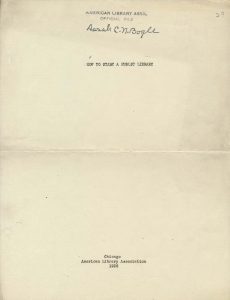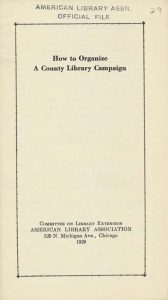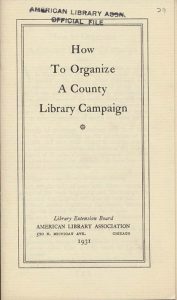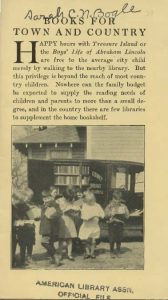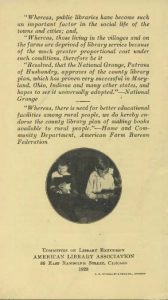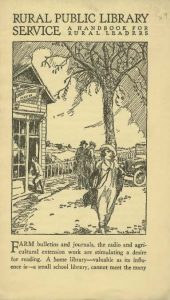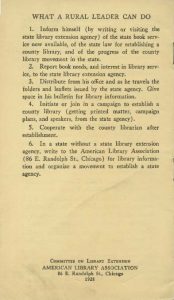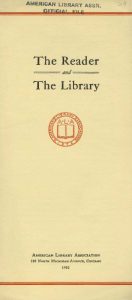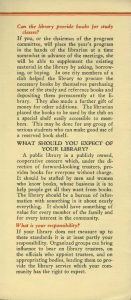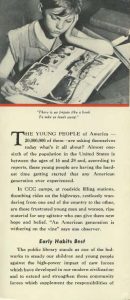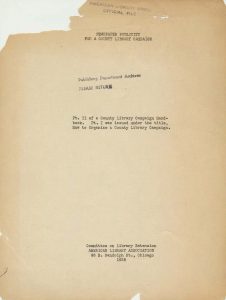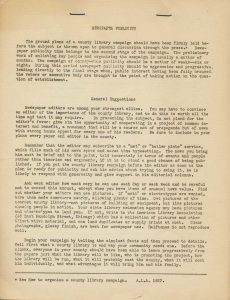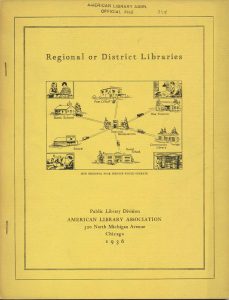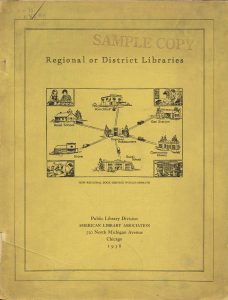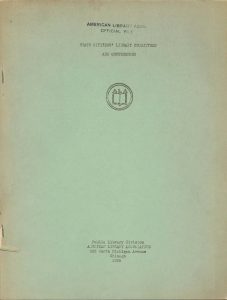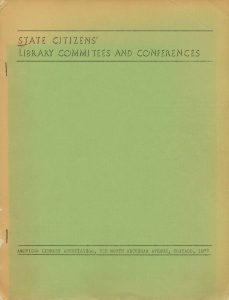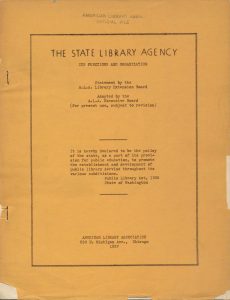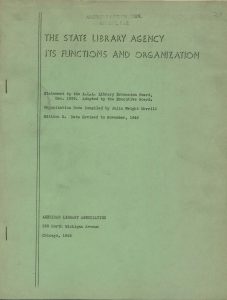Following World War One and A.L.A. War Service program, the American Library Association’ Committee on Library Extension (later Library Extension Board) produced a great many publications supporting the work of county, district, regional, and rural librarians as well as their peers across the United States. Some of these publications can be found in Record Series 29/5/11, which contain brochures, pamphlets, and administrative reports, as well as a few surprises too.
Read on to learn about Library Extension Board publications!
Brochures, Fact Sheets, and Leaflets
From the early 1900s through the 1910s, a variety of publications were produced to inform readers about the administration and practice of library extension work. One striking example is “How to Build a Library”. In twenty-two steps, as you might have read–here first–in a previous blog post, the process of planning a library was explained. Later editions, during the 1920s and 1930s, tailored for county library campaign work, were distributed as pamphlets with significant changes in the layout and design. Take a look for yourself at the four covers below.
At the same time, a great variety of specialized publications described and promoted library services to all of society. Later publications included a variety of images and photographs to show the impact of libraries and the potential for more libraries in society.
The 1928 “Books for Town and Country” is a handy fifteen-page publication describing the benefits of county libraries services to a general audience. With a black-and-white photograph of library services on almost every page, the publication highlights how county libraries can deliver books to readers, provide low cost reading opportunities for counties, supplement county school educational programs, and provide both pleasure as well as vocational reading materials for all readers of all interests.
The 1928 “Rural Public Library Service” is an equally handy fifteen-page publication describing the benefits of rural libraries to local and state government administrators as well as rural authorities too. Similar to “Books for Town and Country” but without photographs, this publication describes the administrative needs of rural public libraries and it includes a list of recommended A.L.A. leaflets for more information.
Circa 1930, at least two publications produced to describe public library services to general audiences. First, “The Reader and The Library” anticipates frequently asked questions about public library services with short essay answer responses. There are no images. Second, “When a Feller Needs a Book” provides a great variety of black-and-white photographs describing how public library services can help educate the public, provide access to vocational literature for Depression job seekers, and help engage youth in society (as seen in the fourth image above).
Newspaper Publicity for a Public Library Campaign
Following the publication of the 1927 “How to Organize a County Library Campaign”, the 1928 partner publication “Newspaper Publicity for a County Library Campaign” provides concise guidance for library leaders interested in promoting publicity of libraries in newspapers (and other media too). The publication includes four pages describing newswriting standard practices, twenty pages of sample article templates, and ten pages of sample editorial templates, for publicists to fill-in-the-blank before sending to local newspapers.
Regional or District Libraries (later Regional and District Libraries)
The planning movement is giving new emphasis to the need of a unit of library service larger than most counties – a district, a region, a metropolitan area. The national plan for libraries, adopted by the Council of the A.L.A. in 1934, includes the following statement:
Each state should have a system of public libraries available for all its population. A comparatively small number – say five hundred – large public library systems might provide better service for all the people in the United States than is now available except in a few cities and counties. Each system might serve a large county or several counties or a large metropolitan area. The emphasis should be on the natural area of interest, irrespective of city, county, or possibly even state lines. Each community would have a branch of the large library system or a community library federated with other community libraries in a large system. (Regional or District Libraries, page 1).
The Regional or District Libraries pamphlet is written for state administrators and leaders to know the breadth of existing regional or district library systems in the United States. The opening essay “Why Regional Libraries”, describes the challenges of providing library services at the county-level, while the district or regional systems could help provide access and wider circulation across greater distances. The following section, titled “Progress”, comparatively describes the existing district and regional systems, including examples from U.S. metropolises, New England, and the United Kingdom. The third section, “Questions of Policy”, includes recommendations regarding how to determine the size of a library community, whether to pursue a state or local approach, and general issues about financial support for such libraries. The fourth section is a reference bibliography for more information, and the appendix includes same library laws from British Columbia, Michigan, and South Carolina.
While the twenty-seven page 1936 edition contains all of the above information, the fifty-page 1938 edition is the first edition to identify Library Extension Board Secretary Julia Wright Merrill as the compiler. The 1938 edition features all sections expanded, with the new inclusion of library laws from Mississippi, New Hampshire, and Nova Scotia.
The forty-one page 1942 edition is a reorganized edition, featuring an expanded policy questions section and the replacement of library laws with sample library contracts from Alabama, British Columbia, California, and Vermont.
State Citizens’ Library Committees and Conferences
Complete coverage of the United States and Canada with good local public library service will obviously come only when the people themselves demand it. Wise librarians have long realized that securing library legislation, establishing new libraries, and providing and maintaining adequate library appropriations depend on citizen interest. When action on a specific library matter is pending, it is customary to conduct an intensive campaign to secure citizen support. Experienced librarians know that such a campaign should be the culmination of a constant process of keeping citizens informed of library needs. State-wide citizens’ library committees, whose concern it is help plan the library program as well as carry it out, can always be called on in a crisis and are an ever-ready channel for library publicity. Citizen requests for library measures also have the advantage of being disinterested, while those of a library group may seem to be motivated by self-interest. (State Citizens’ Library Committees and Conferences, 1935, page 3).
Published in 1935, the first edition includes sections on the objectives of state-wide citizen’s groups, examples of such groups in different states, and how to organize those groups. In particular, three types of groups are emphasized: standing committees of citizens interested in libraries (also known as state citizens’ library committees), citizens’ library conferences (who meet, annually, to discuss library needs from across the state), and citizens’ library planning groups (which can be citizen-wide or primarily librarians too). The appendix includes sample forms and publicity materials too. The second edition, published in 1937, includes recognition of Grace W. Estes as the compiler and an expanded reference works section too.
The State Library Agency: Its Functions and Organization
For libraries as for schools, the state has a responsibility for the provision of adequate service for all its inhabitants. This responsibility has been tacitly recognized in practically all the states; now it is being written into state laws.
The state should provide an official state library agency to carry out this responsibility and to develop and coordinate library service throughout the state. Most states have set up such library agencies but many of them are very inadequate.
Libraries are essential in a democracy, dependent as that is on enlightenment of the people and on the vitality of their cultural and social ideas. Modern trends in continuing or adult education, and in use of many books in school and university, make libraries basic in the whole educational scheme. At the same time, they are greatly affected by modern inventions, such as radio, by population trends and by governmental trends. Vigorous leadership on the part of state library agencies, alert to changing conditions and opportunities, seems fundamental to library progress. (The State Library Agency: Its Functions and Organization, 1937, page 2).
The 1937 edition includes, as promised, both a description of state library agencies and a description of its organization, in addition to recommending organizational models. Of equal interest to researchers might be the comparison of state library agency structures as well as a comparison of other state information agencies including archives and historical societies. Although the A.L.A. Archives does not yet have the second through fourth editions, the fifth edition, published in 1945 and notably citing Julia Wright Merrill as the compiler, is primarily updated information on each state agency.
Copies Available at Your ALA Archives
Physical copies of Library Extension Board publications are available for viewing at the ALA Archives and additional unlisted publications are available too. Please view the Record Series 29/5/11 database record entry, for information.
Got Something to Donate to the Story So Far?
Many people have been involved in the A.L.A. Library Extension Board and the successor public library organizations including today’s Public Library Association. Do you have any information about A.L.A. Library Extension Board participants, collaborators, publications, or beneficiaries? Please contact us through social media. We and our readers would like to read about it.

